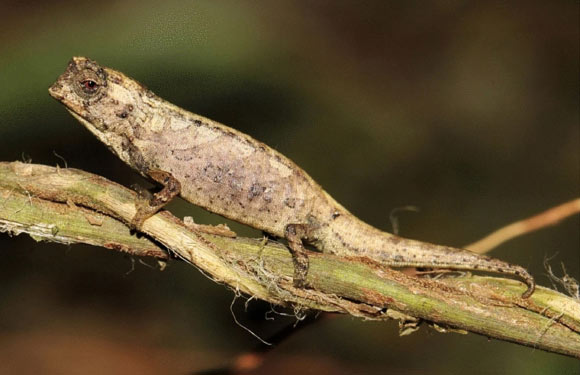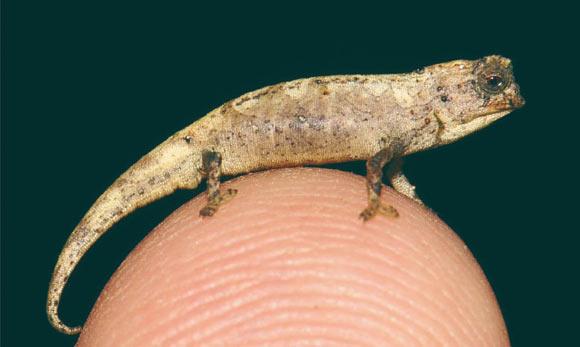An international team of scientists has discovered a new, extremely miniaturized species of the chameleon genus Brookesia living in a montane rainforest in northern Madagascar.
“The chameleon genus Brookesia consists of predominantly terrestrial species divided in two major lineages, which diverged from each other about 40-50 million years ago,” said Dr. Frank Glaw, curator of herpetology at the Bavarian State Collection of Zoology, and colleagues.
“One of these lineages includes larger species of 3.4-6.6 cm snout-to-vent (SVL) length, while the other contains only highly miniaturized species.”
“At present, 12 described species are known from this clade, none of which exceeds 3 cm SVL, with the smallest species Brookesia micra reaching a maximum adult female SVL of 1.99 cm.”
The newly-discovered species, named Brookesia nana, is smaller than other tiny species of the genus, measuring 1.4 cm SVL in an adult male and 1.9 cm in a female.
“At a body length of just 1.35 cm and a total length of just 2.2 cm including the tail, the male ‘nano-chameleon’ is the smallest known male of all higher vertebrates,” Dr. Glaw said.
Brookesia nana is only known from a degraded montane rainforest in northern Madagascar and might be threatened by extinction.
“Most miniaturized Brookesia are rainforest species, which inhabit mostly forests in lowlands and rarely at higher elevations over 1,000 m above sea level. Other species prefer dry forest, especially on karstic underground,” the researchers said.
“The majority of species exhibit very small ranges, with only few species being known from more than two locations.”
“This microendemism may be related to the complex topography in northern Madagascar where these and other Brookesia species are predominantly distributed.”
“The ‘island effect’ that causes species on small islands to get smaller in body size, which has been invoked for other small chameleons, does not make sense in this case, because Brookesia nana lives in the mountains on mainland Madagascar,” said co-author Dr. Fanomezana Ratsoavina, a researcher at the Université d’Antananarivo.
“Unfortunately, the habitat of Brookesia nana is under heavy pressure from deforestation, but the area has recently been designated as a protected area, and hopefully that will enable this tiny new chameleon to survive,” said co-author Dr. Oliver Hawlitschek, a researcher in the Centrum für Naturkunde at Universität Hamburg.
According to the scientists, the Brookesia nana male they studied has unusually large hemipenes (chameleon genitals), making it apparently the smallest mature male amniote ever recorded.
“There are numerous extremely miniaturized vertebrates in Madagascar, including the smallest primates and some of the smallest frogs in the world, which have evolved independently,” said co-author Dr. Andolalao Rakotoarison, a researcher at the Université d’Antananarivo.
“But why this species is so small remains a mystery.”
The discovery is reported in a paper in the journal Scientific Reports.
_____
F. Glaw et al. 2021. Extreme miniaturization of a new amniote vertebrate and insights into the evolution of genital size in chameleons. Sci Rep 11, 2522; doi: 10.1038/s41598-020-80955-1









